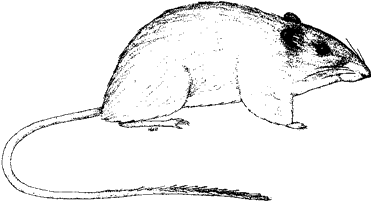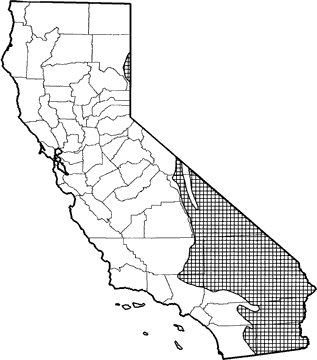
Long-tailed Pocket Mouse
Distribution, Abundance, and Seasonality
In California, the long-tailed pocket mouse occurs in arid habitats from eastern Mono Co. south through the Owens Valley and throughout the Mojave Desert. It is also found in southeastern Lassen Co. Common in sagebrush, desert scrub, and desert succulent shrub habitats with rocky or stony groundcover (Hall 1946, French et al. 1966, Beatley 1976b). Uncommon in a variety of other desert habitats. Elevational range from -85-1970 m (-282 ft-6500 ft).

Range Map
Specific Habitat Requirements
Feeding: Mainly granivorous, but feeds opportunistically on green vegetation and insects (Bradley and Mauer 1973, French et al. 1974). Seeds are collected on the ground beneath and between shrubs, and on rocky surfaces.
Cover: Distribution and abundance seem to depend on soil characteristics rather than on shrub parameters. Found in sparse to dense canopy of a variety of desert shrub species (Beatley 1976b).
Reproduction: Burrows are excavated in gravelly or rocky banks, or at base of shrubs.
Water: Does not drink free water. Obtains water from food, particularly green vegetation.
Pattern: Rocky or stony slopes or canyons with sparse to dense desert shrub canopy. Most often associated with rocky washes and canyon mouths (Miller and Stebbins 1964).
Species Life History
Activity Patterns: Nocturnal. Active on surface through much of the year with exception of late fall through early spring (French et al. 1967, Bradley and Mauer 1973). Below-ground activity and aestivation related to period of cold weather (French et al. 1967). Increasing above-ground temperatures accompanied by increasing activity. In summer, 30-40% of time is spent above-ground (French et al. 1966). Daily cycle involves burst of activity shortly after sunset for 2 hr followed by a cessation of activity at 6 hr after sunset (O'Farrell 1974).
Seasonal Movements / Migration: None.
Home Range: Males have larger home range than females, and range size is inversely related to population density. The 95% recapture radius in several habitat types in Nevada was 67-108 m (221-356 ft) for males, and 41-65 m (135-215 ft) for females (Jorgensen and Hayward 1965). Home range averaged 2.4 ha (5.9 ac) for males and 0.8 ha (2.0 ac) for females. Densities fluctuated seasonally from 0.04-1.3 individuals per ha (0.2-0.5/ac). Home range averaged 0.55 ha (1.36 ac) in the Moiave Desert (Maza et al. 1973).
Territory: Aggressively solitary. The repertoire of agonistic behaviors includes rushing, locked fighting, kicking, leaps, and sand kicking (Eisenberg 1963). Death of one individual almost invariably results when pairs are housed together under lab conditions.
Reproduction: Breeding occurs from April to July in California, peaking in May and June. Litter size averages 5 young (range 1-6) (French et al. 1974), usually with 1 litter per yr. In most years animals are 10-12 mo old before breeding, although young-of-the-year may breed shortly after weaning in years of exceptional food supply (French et al. 1974).
Niche: Primarily a granivorous rodent of arid desert habitats with rocky soils. Sympatric with Neotoma lepida, Dipodomys merriami, and Perognathus longimembris, but distinct niche differences are apparent in each case. Predators include owls, snakes, leopard lizards (French et al. 1967), kit foxes, and other predatory mammals. C. formosus is host to at least 10 species of mite (Allred 1963), 3 flea species (Beck and Allred 1966) and 3 tick species (Beck et al. 1963).
Comments: Showed no immediate population response to off-road vehicle damage to its environment after 1 year. Animals were sampled only 3 times during this period, and the results should be used with caution (Vollmer et al. 1976). In the Owens Valley, most abundant along the California aqueduct; the rocky banks resulting from construction provide excellent burrow habitat.
Sources & References
California Department of Fish and Game, 1999.
California's Wildlife, Sacramento, CA.
Written by: P. Brylski, reviewed by: H. Shellhammer, edited by: R. Duke
Allred, D. M. 1963. Mites from pocket mice at the Nevada test site. Proc. Entomol. Soc. Wash. 65:231-233. Beatley, J. C. 1976b. Rainfall and fluctuating plant populations in relation to distributions and numbers of desert rodents in southern Nevada. Oecologia (Berlin) 24:21-42. Beck, D. E., and D. M. Allred. 1966. Siphonaptera (fleas) of the Nevada test site. Brigham Young Univ. Sci. Bull. Biol. Ser. No. 7. 27pp. Beck, D. E., D. M. Allred, and E. P. Brinton. 1963. Ticks of the Nevada test site. Brigham Young Univ. Sci. Bull. Biol. Ser. No. 4. 11pp. Bradley, W. G., and R. A. Mauer. 1973. Rodents of a creosote-bush community in southern Nevada. Southwest. Nat. 17:333-344. Eisenberg, J. F. 1963. The behavior of heteromyid rodents. Univ. Calif. Publ. Zool. 69:1-114. French, N. R., G. Maza, and A. P. Aschwanden. 1966. Periodicity of desert rodent activity. Science 154:1194-1195. French, N. R., B. G. Maza, and A. P. Aschwanden. 1967. Life spans of Dipodomys and Perognathus in the Mojave Desert. J. Mammal. 48:537-548. French, N. R., B. G. Maza, H. U. Hill, A. P. Aschwanden, and H. W. Kaaz. 1974. A population study of irradiated desert rodents. Ecol. Monogr. 44:45-72. Hall, E. R. 1946. Mammals of Nevada. Univ. California Press, Berkeley. 710pp. Jorgensen, C. D., and C. L. Hayward. 1965. Mammals of the Nevada test site. Brigham Young Univ. Sci. Bull., Biol. Ser. No. 7. 81pp. Maza, B. G., N. R. French, and A. P. Aschwanden. 1973. Home range dynamics in a population of heteromyid rodents. J. Mammal. 54:405-425. Miller, A. H., and R. C. Stebbins. 1964. The lives of desert animals in Joshua Tree National Monument. Univ. California Press, Berkeley. 452pp. O'Farrell, M. J. 1974. Seasonal activity patterns of rodents in a sagebrush community. J. Mammal. 55:809-823. Vollmer, A. T., B. G. Maza, P. A. Medica, F. B. Turner, and S. A. Bamberg. 1976. The impact of off-road vehicles on a desert ecosystem. Environ. Manage. 115-129.
California Animal Facts | California's Wildlife